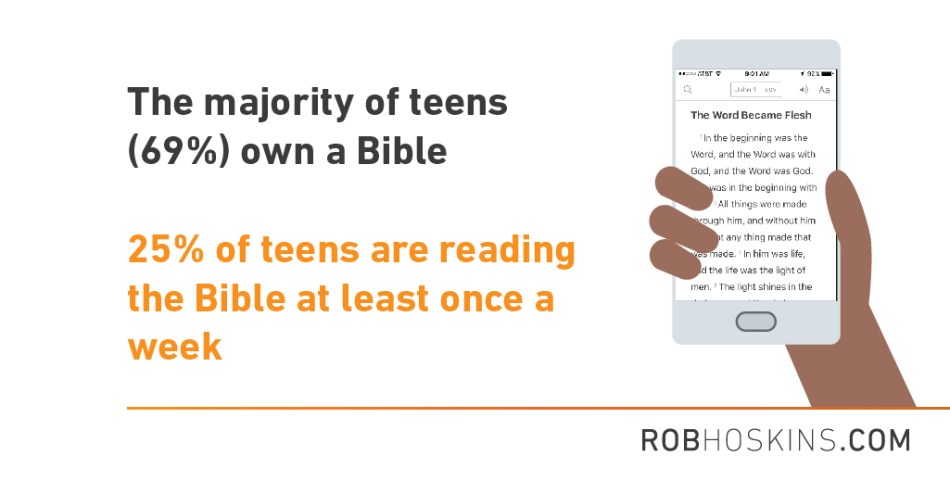Bible reading is up
Barna’s “Top 10 Findings on Teens and the Bible,” highlights some promising trends when it comes to teens and the Bible¹:

Biblical literacy rates are dropping
While encouraging, a quick exploration of additional research reveals the deeper issue of biblical illiteracy.
BIBLICAL ILLITERACY: While many teens may be reading the Bible, most are not engaging with Scripture at the depth or frequency needed to internalize its messages. Biblical literacy is at an all-time low among teens, as well as their adult youth leaders and parents. Most teens and adults lack understanding of core biblical doctrines and the full metanarrative of Scripture.
American Bible Society’s 2016 “Teen State of the Bible” report includes data that shows 75% of teens are reading the Bible once a month or less. This unfortunately means that its influence in daily life is dwindling:
 ³
³

4
The gauges of true Scripture engagement
If youth are not engaging with Scripture in a way that is bolstering spiritual maturity, what must we do to help them? Indicative of a person who is regularly and increasingly engaging with God’s Word are:
Biblical Knowledge
Help students to read and articulate the biblical story.
When students read the Bible with greater regularity and for substantial periods of time, they will better understand the ‘who’ and ‘what’ of Scripture: the people involved, and how they relate to one another.
Biblical Competency
Help students to interpret and (self)-reflect on the biblical story.
As engagement with the Bible compounds, competency increases. Students are able to process the ‘why’ of Scripture, asking deeper questions about the meaning of the text and its context.
Biblical Influence
Help students to live out and respond to the biblical story with their own lives as they relate to God, the world, and others.
As students grow in their knowledge and experience of God’s love for them, they will respond by loving God and their neighbor. Once a person is able to recognize that the story of the Bible directly relates to their own life, they can see how their life is a part of God’s story.
The cycle of growth
The relationship between bIblical knowledge, competency, and influence is more nuanced than sequential. The categories are mutually informing–each with the capacity to inform and shape the other two. There are significant overlaps between the categories, and the common denominator for growth is frequency spent in God’s Word over time.
The most reliable metric
When teens are truly engaged in God’s Word, the biblical influence will be evident. Not only will it be seen in their own life, but as the Bible’s influence seeps into all areas of their lives, it will influence others when they begin to live faithfully in response to God’s love and grace and in accordance with biblical teaching.
While we can quantify time spent in God’s Word, the true indicator of Scripture engagement is life transformation.



